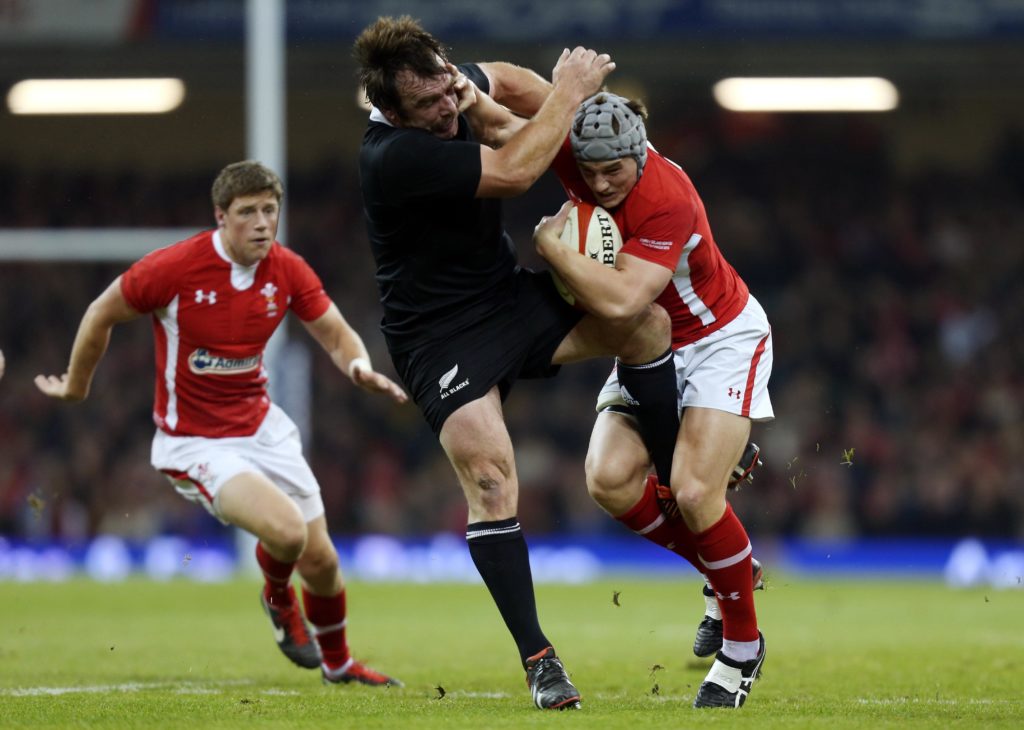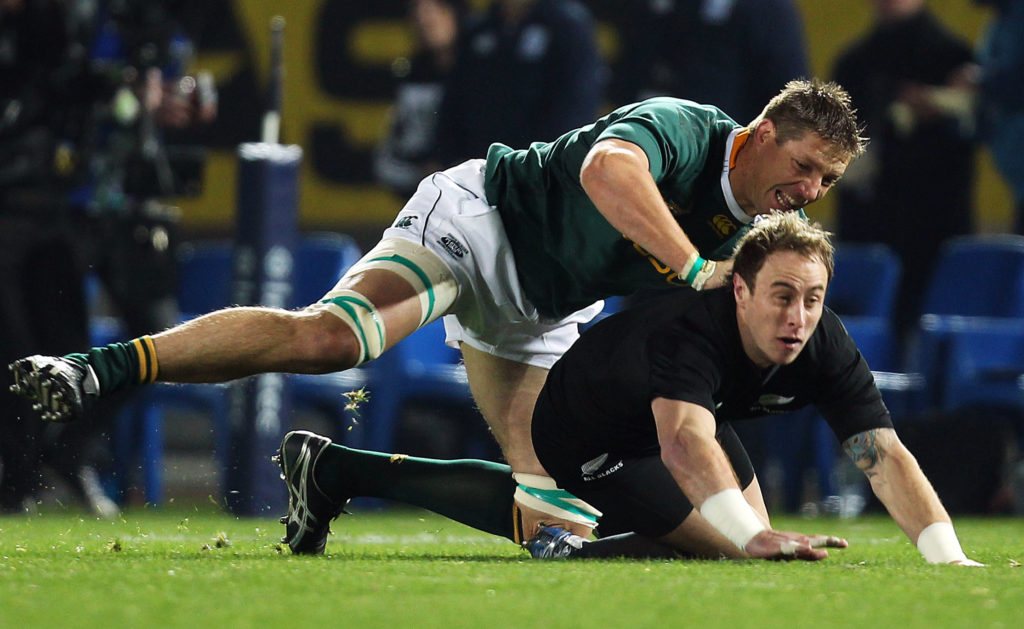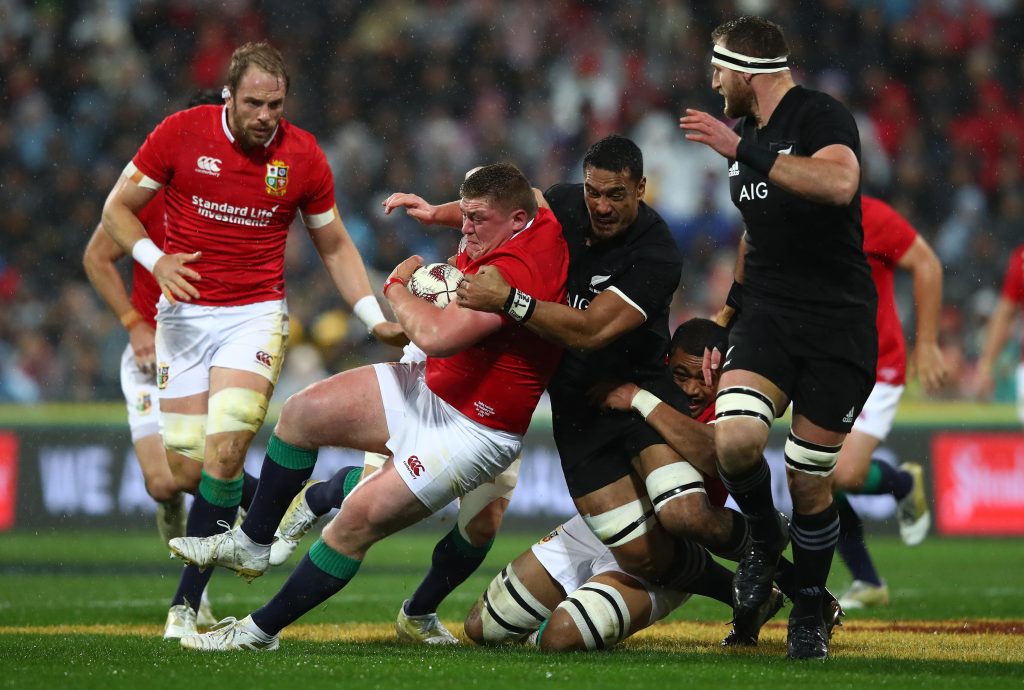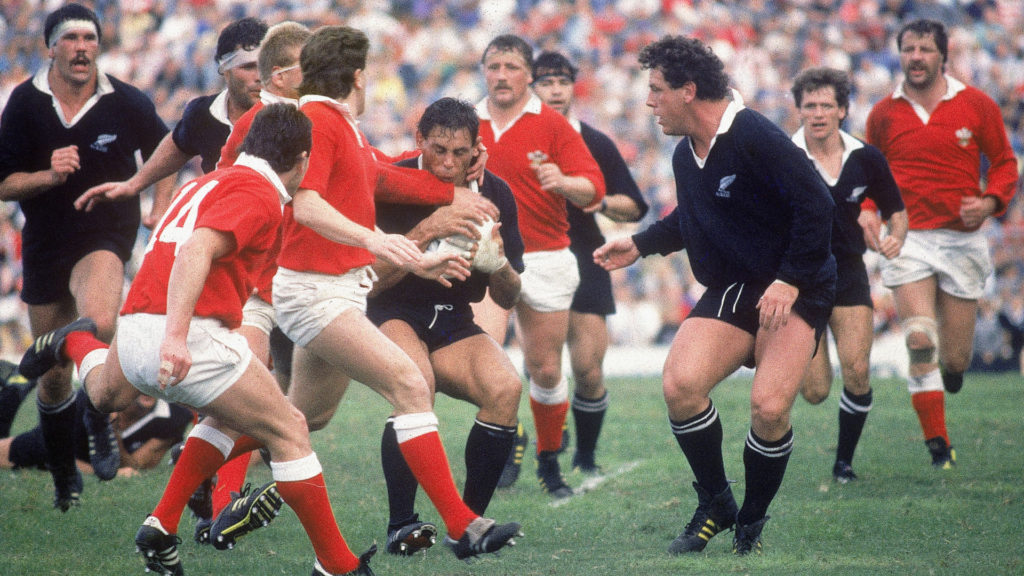The list of atrocities committed by various All Blacks over the years is long and memorable. The world’s greatest rugby team has never been in doubt that eggs have to be broken to make an omelette.
As much as they have thrilled with their creativity and imagination over the years, they have been equally prepared to use brute force to get the job done and play outside the law if they have felt that’s what was needed to win.
This dark side to the All Blacks was revealed in 1924 when Cyril Brownlie became the first man in test rugby to be sent off, accused of stamping on a prone English player at Twickenham.
The second man to be marched off was the great Colin Meads, when he was red-carded at Murrayfield in 1967 for kicking Scotland’s fly-half David Chisholm in the head.
It didn’t take long for the North to see that the All Blacks could be one part beauty, two parts beast. And while only two other red cards have been shown to All Blacks – Sonny Bill Williams against the Lions in 2017 and Scott Barrett against the Wallabies in 2019 for high tackles – that’s by no means a basis on which they can profess to holding a relatively clean rap sheet or claim that Browlnie and Meads were the exception rather than the norm.
When a tree falls in the woods without anyone acting as witness, it still falls and by the same token a wild and reckless action on a rugby field that isn’t seen by the officials, still happened.
Which is why there are rugby followers in Bridgend who will never forgive John Ashworth, the bruising All Blacks prop, who stamped on the head of JPR Williams so hard in 1978 that he put a stud through the great fullback’s cheek which required 30 stitches.
Australians, too, know for sure that in 1992 Richard Loe drove his forearm into Paul Carozza’s face after the Wallabies wing had scored in the first test of the Bledisloe Cup series. Carozza’s nose was broken in what was a cowardly and needless assault by Loe, even if the officials somehow decided not to see it.
The following year at Twickenham, All Blacks flanker Jamie Joseph stamped on England debutante Kyran Bracken. It was a sneaky but damaging attack by the man now coaching Japan – he saw Bracken on the ground and managed to partially dislocate the scrum-half’s ankle with a few choice words as he did so.
The Lions are never going to accept that the incident in the first minute of the first test of the series in 2005 which saw captain Brian O’Driscoll removed on a stretcher was an accident. He was picked up and dropped on his shoulder by All Blacks captain Tana Umaga and hooker Keven Mealamu and it had the feel of an intentional rather than clumsy act.
And in 2012 All Blacks hooker Andrew Hore clubbed Welsh lock Bradley Davies from behind in the first minute of their test in Cardiff. Davies was knocked unconscious and carried off, unable to play for a month as he worked through concussion symptoms.

The All Blacks, then, are no strangers to filth. They have committed appalling crimes in their illustrious history and yet, strangely, they have never produced or tolerated the idea of having an out-and-out, beyond-the-limits enforcer in their midst.
They have had tough, unbreakable types in their ranks since they first played. As a pioneering nation they have been drawn to rugged men who have been equipped with resilience and a capacity to endure extremes.
Meads played with a broken arm in South Africa and Buck Shelford stayed on the field in the infamous 1986 Battle of Nantes, despite the fact he needed 50 stitches in a torn testicle. Richie McCaw played an entire World Cup with a broken foot and All Blacks folklore is rich with stories about players being driven by an almost insane level of commitment.
Their mentality has long been ruthless and while various individuals have committed memorably violent acts, no one has been able to carve out a career as an All Blacks hit-man.
New Zealand, in stark contrast to other nations, has never embraced the concept of employing a euphemistically termed enforcer to intimidate opponents.
Bakkies Botha lasted 12 seasons with the Springboks, winning 85 test caps as a revered and admired enforcer – applying himself as a free-spirited trouble-shooter, whose jurisdiction stretched well outside the law-book.
Their mentality has long been ruthless and while various individuals have committed memorably violent acts, no one has been able to carve out a career as an All Blacks hit-man.
Nothing was off limits for Botha – head butting, eye-gouging, stamping and biting were all part of his repertoire and despite being a liability, the Boks liked that he brought a reputation to the test arena and that he struck an element of fear into opponents.
They stuck by him no matter his crime and his endless suspensions were worn as a badge of honour and celebrated by the Boks.
Ireland happily picked Peter Clohessy throughout the late 1980s and 1990s, knowing he relished, and lived up to his moniker of ‘The Claw’.
Clohessy’s single greatest crime was an intentional and vicious stamp on the head of French lock Olivier Roumat in 1996, but he’d admit to so much more now that he’s long retired.
France have had an endless love of enforcers, wild men willing to unleash their fury anyway they could. In the 1970s, playing a Five Nations match in Paris was the least favourite 80 minutes for all the Home Nations.

Michel Palmie was perhaps the most vicious but it was hardly as if Laurent Seigne, Olivier Merle, Robert Papermborde or Eric Champ were shrinking violets.
England found a home for the self-styled tough guy Mick Skinner while it could be argued that their love of the rule-bending hard man was signalled by their decision to award both Martin Johnson and Dylan Hartley with the captaincy of the national team.
Scotland’s Jim Hamilton would qualify as an enforcer, at least in his own mind as would Paul O’Connell. Canada’s Jamie Cudmore would most definitely be considered an enforcer and a case could be made to apply that term to Scott Higginbotham of the Wallabies.
Almost every team in the world has found a place for those men who have built their reputation outside the confines of the laws of the game.
Every nation that is except for New Zealand, where the concept of an enforcer is not so much anathema as one that has never appealed.
Richard Loe, who is about as close to being an enforcer as the All Blacks have ever had, can remember being pulled aside by Meads before one of his first games for the national team in 1986.
The All Blacks were about to play the French Barbarians and team manager Meads was aware that Loe, called into the squad as an injury replacement, had a burgeoning reputation as something of a hard man.
“These are the dirty bastards,” confided Meads. “Make sure you are wearing the longest studs you have and get stuck in.”
The message was open to interpretation. Loe read it as a licence to use his judgement to do what he felt was necessary. At one point, the referee, who didn’t speak much English, threatened to send him off, but Loe looked confused, apologetic even and it earned him a reprieve.
It was a job well done in the end as he subdued the French, stayed on the field and helped the All Blacks win. If, however, he had been sent off, he’d never have lasted as an All Black.
New Zealanders do tough and uncompromising and they are prepared to explore the referee’s limits. If they can get away with a bit of filth they have the pragmatism to write it off as a necessary means to justify a satisfactory end.
But there is zero tolerance if an act of violence negatively impacts the All Blacks. It’s such a cold, calculating environment that anything which helps the team is allowable, whereas anything that doesn’t will have consequences for the perpetrator.

The risks, then, of indulging in illegal acts of enforcement are too high. Most All Blacks know they will pay a price if they transgress – that they might get lucky, but the laws of probability stack against that being a likely outcome despite the evidence seemingly pointing to the contrary.
In 1987 Shelford punched Huw Richards unconscious in the semi-final of the World Cup, an act which somehow ended with the Welsh lock being red carded and the All Blacks No 8 not even spoken to by referee Kerry Fitzgerald.
Shelford never speaks about it now because he knows he risked way too much by doing what he did and jeopardised – or at least should have – the team’s prospects of winning.
The incident in Bridgend was also one that everyone who saw it, knew should have led to a red card and significant ban for Ashworth. While he avoided sanction on the day, the message was clear that he wouldn’t be winning many more All Blacks caps if he ever did anything like that again.
“I said so at the time, that it was unacceptable,” says former All Blacks captain Graham Mourie. “I think Ashworth would say I didn’t mean to, it was an accident.
“I mean, that’s always the fall back but I think certainly with that and other instances, there were one or two when I played, where I certainly made my feelings known to the players. That sort of stuff was unacceptable and certainly within the team players were given a very clear message about it.”
That refusal to celebrate or endorse reckless acts which have resulted – or should have – in sanctions that hurt the team, has never wavered within the All Blacks.
I mean, that’s always the fall back but I think certainly with that and other instances, there were one or two when I played, where I certainly made my feelings known to the players. That sort of stuff was unacceptable and certainly within the team players were given a very clear message about it.
Former All Blacks captain Graham Mourie
Hore’s All Blacks career was effectively ended when he picked up a four-week ban for his cheap shot on Davies in 2012. It was the moment All Blacks coach Steve Hansen knew the long-serving hooker could no longer be trusted.
It was a miracle he avoided a red card in Cardiff – a travesty of officialdom that he didn’t. The All Blacks won 33-10 but would they if they had been forced to play 79 minutes with 14 men.
Another veteran, Owen Franks, didn’t make the 2019 World Cup squad. Officially it was because he was deemed to lack the mobility and ball carrying ability of other props. But unofficially, there was concern that his propensity to tackle high and lead with his forearm would have almost certainly led to a red card being shown at some point in the tournament.

The All Blacks coaches of the professional age, especially Hansen, could see the direct line between discipline, or lack of, and outcomes.
Between 2017 and 2019 the All Blacks lost six tests and were shown red cards in two of them and on that basis, the All Blacks have never been able to mathematically justify the risks of carrying or nurturing an enforcer.
They have welcomed tough and explosive figures such as Jerry Collins, Jerome Kaino and Brad Thorn – all of whom were combative, abrasive and quick to the scene of any off the ball flare-ups – but never wild or reckless.
Someone such as Troy Flavell, however, fell the wrong side of what they were after and hence never managed to build a long All Blacks career.

Flavell was 2.02m, 120kg of raw athlete who could play blindside as well as he could lock. But his fingers strayed into someone’s eyes once during a provincial game and then his boot came down hard on the head of Chiefs hooker Greg Smith during a Super Rugby game in 2003 and he was deemed unpredictable.
The risks of picking Flavell began to outweigh the potential rewards and hence his test career never took off.
He’d have been the first name on the team sheet for a decade or more had he been French, but New Zealand just didn’t have the same appetite for his particular brand of carnage.
There’s an infamous picture of Sandy Carmichael, eyes badly bruised, cheekbone split and face barely recognisable as he came off the field at Lancaster Park in 1971.
The British & Irish Lions prop had been punched and kicked to a pulp by the Canterbury forward pack in a game that was effectively a fight punctuated with a little rugby.
The brutality on view that day makes it hard to believe that New Zealanders aren’t naturally drawn to stomach-churning contests where the winners are those who make the bigger statement with their fists and boots.
Whatever happened that day, though, is not a true representation of how things are in New Zealand. It’s not necessarily a strong moral compass that steers Kiwi teams and the All Blacks away from using violence as intimidation, it’s once again pragmatism.
The All Blacks want the game to be fast, clean and open because that significantly increases the odds of them winning. They back themselves to be the better rugby team every time they play, but if the contest descends into chaos – becomes dogged with off the ball scuffles where teams are dragged into brawling at every other breakdown – they lose whatever advantage they had.
They are a brilliant rugby team, not necessarily great fighters and so a descent into lawlessness is not going to enhance their chances of winning.

Former captain Shelford says he toured France with the New Zealand Maori team in 1988 and had to apply strategic logic of it being better to run than fight when they encountered a team intent on punching them off the park.
“I tell you, the king hits were going in during one game,” he says. “So at half-time, I got my interpreter and took the referee to one side and said: ‘You tell this guy if he doesn’t clean up this shit, I will walk my team off’. I was very clear, clean it up or we are walking off.
“We played the second half and while the referee still called it off 10 minutes early, it was cleaner than it had been in the first half. As captain the last last thing you want is for players to be knocked out from behind – which is what happened to one of our props so that was when I said, ‘ah bugger it’ and I went to the referee and put the pressure on him. You don’t want those sorts of games because they are not what rugby is about.
“I love it now that the game has been cleaned up through the cameras. You don’t see that crap anymore and it is a safer game in that respect now.”
The All Blacks have clearly rationalised that a random cheap shot may work from time to time, but the deployment of an enforcer, designed to provoke and aggravate, would statistically stack the odds against them.
As captain the last last thing you want is for players to be knocked out from behind – which is what happened to one of our props so that was when I said, ‘ah bugger it’ and I went to the referee and put the pressure on him. You don’t want those sorts of games because they are not what rugby is about.
Former All Blacks captain Buck Shelford
Certainly for the last 20 years, the All Blacks have pursued a high tempo, fluid style which simply hasn’t afforded any room to carry an off the ball enforcer. Why punch opponents off their feet when the All Blacks can run opponents off their feet?
The All Blacks don’t want to get caught in an arm wrestle, or duke it out with their opposition in an attritional grind and therefore the sorts of cult enforcement figures that have flourished in other countries, have never been able to win regular test selection in New Zealand.
Mobility, athleticism and ball skills are the priorities for all players to demonstrate, so picking a brute to throw his weight around simply isn’t in the New Zealand mindset, unless said brute is able to consistently demonstrate that he can physically damage teams entirely legally.
But then players who tackle hard, cleanout effectively and carry with great impact are not enforcers as such, but great players and the All Blacks have picked plenty of those.
Former All Blacks coach Steve Hansen was not going to entertain any notion that his side had been guilty of anything other than total commitment in Dublin, 2016.
The All Blacks had beaten Ireland 21-9 in a contest that was about as full-blooded as any in the professional age. There were two yellow cards shown to New Zealand in a game that had countless collisions that were frankly hard to watch, never mind endure.
When he was pushed for a third time by RTE’s post-match interviewer Claire McNamara to explain the nature of some of the tackling, he snapped: “Do you want me to tell you we’re a dirty side or something? Is that what you’re saying?”
His prickliness was illustrative of the frustration he was feeling at having seen his side flirt with danger all game. The All Blacks had pushed the bounds of acceptable aggression and execution and as much as that was a failure to live up to their internal expectations around discipline, it carried the wider possibility of damaging the brand.

And this is yet one more reality that impacts the All Blacks and steers them away from endorsing a culture of enforcement or picking those who revel in the dark art of intimidation by violence.
The All Blacks are the financial bread winner in New Zealand. About 70 per cent of the approximate $200 million of annual revenue generated by professional rugby in each of the last three years is directly attributable to the All Blacks.
The grassroots game and indeed provincial and Super Rugby, live off the power of the All Blacks’ brand. About $80m a year is generated through broadcast income – most of which is attached to the All Blacks test programme, while AIG pay around $12m a year to have their name on the famous jersey and other sponsors tip in around another $60m a year to be associated with the best known team in the world.
The All Blacks are a brand and they are a brand built on values of trust, discipline, teamwork, unity and respect. The concept of an enforcer does not fit into that vision on any level and nor does the incessant brutality that was on display in Dublin four years ago.
It would be laughable to say the All Blacks are beyond reproach. Silly to believe they don’t have individuals capable of crass and cynical acts to help them win.
They can look after themselves just fine but in their 115-year test history, they have never had what the rest of the world would recognise as an enforcer.



Comments
Join free and tell us what you really think!
Sign up for free